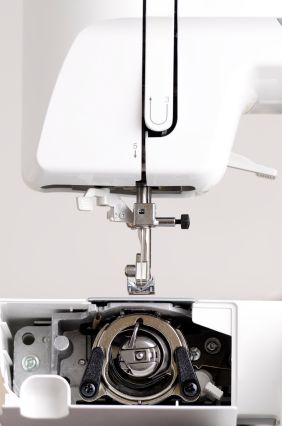There is nothing quite so frustrating as sitting down to sew and instead of hearing the smooth purr of your machine, its language changes to kkkalunk, grrrrrowl, and bird nests grow where a uniform stitch should be. This behavior can mean many things, but the most likely cause is an unhappy machine crying for some light maintenance. Ninety percent of the time a little oil, tension adjustment or a new sewing machine needle will take care of the issue.

Dusting and oiling work wonders, in that order. Dust particles make your machine work harder, as they reduce the already small spaces between moving parts. Dust also absorbs oil, so clearing the dust out will make your oiling efforts last longer. Nothing replaces a good quality sewing machine lint brush. Run it under the stitch plate and around the bobbin shuttle at least once a month, and more often if you sew for hours every day. A small drop of oil on the brushes help grab dust in hard to reach places. Don’t be tempted to use canned compressed air, as this just compacts dust into the machinery where it’s nearly impossible to remove.
Why oil? Think of the forces your machine tolerates when you sew. Metal parts in contact can only hold up for so long without oil. The tell-tale signs of too little oil are small piles of metal shavings inside the machine, which can be the beginning of the end for your trusty steed. The type of oil you use is important too. Please, please don’t use your husband’s 3-in-1 oil. This stuff has alcohol in it, and is not good for those delicate machine parts. Buy sewing machine oil, because it is designed specifically for sewing machines.
Train yourself to listen to your machine, and learn how it sounds when just tuned and oiled. Machines get progressively noisier with use, and it’s amazing how much a bit of oil quiets them down. Notice I said “a bit.” Too much oil is just as damaging as too little. This is the main reason your sewing shop recommends annual maintenance, because most of us are too lazy to learn how to care for our machines. Or we’re too fearful we’ll screw them up.
I helped a friend tune up her machine a few weeks ago, and when I asked her how often she oiled, her reply was “Never! I don’t want to get oil stains on my projects!” While this practice keeps your fabrics clean, it isn’t the best way to care for the machine. One remedy for cleaning up after machine maintenance is to sew on some fabric scraps which will absorb excess oil.
It’s a good idea to write down when you oil your machine and establish a maintenance routine if you don’t have one set up. The rule of thumb is to oil every 40 hours of machine use, but if you sew sporadically that’s hard to determine. For the average sewist, once a month is adequate. That works out to about 8 hours of sewing a week.
Don’t be afraid to solve a sewing machine mystery yourself. Worst case scenario is if you can’t fix it, you take it in for a tune up or repair. Usually it won’t cost any more if you make it worse. For those of you who don’t want to get your hands dirty, and have the $75 to $120 fee, your repair person will love you. Show your machine some love, and you will reap the rewards of a long and happy time together.








